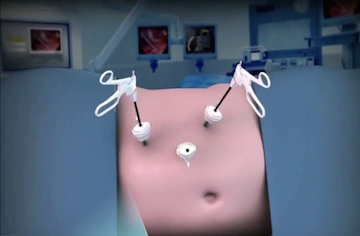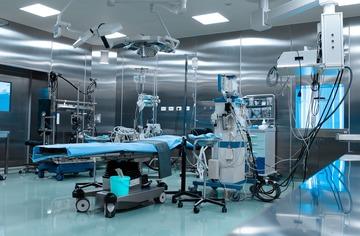TURP
TURP (transurethral resection of the prostate) is an endoscopic surgical procedure which is aimed at removal of the growth and normalising the function of urination. This procedure is performed via the urethra and without making an incision. In this article I will tell you more about various aspects of this surgery.
Treatment of benign prostatic hyperplasia: TURP
Every urologist comes across 3 standard situations when treating benign prostatic hyperplasia:
- After a long treatment with medication and constant changing of medication and upping the dosage the patient still complains about interrupted urinary flow, getting up to urinate at night and the need to strain when urinating.
- The patient already suffers from various complications of benign prostatic hyperplasia, such as bladder stones, large amounts of retained urine, widening of the kidneys and chronic urine retention.
- The patient has suffered episodes of acute urine retention
In all of the above cases the patient is usually referred for transurethral resection of the prostate by their urologist. At first glance a very common procedure. But here we have a small issue. For a urologist this treatment, or TURP is just a common procedure and for the man referred to have it done it is not quite the case.
TURP and men
For any man TURP raises a whole list of worries, uncertainties and questions: How will the operation go and will it help? What are the possible complications? What will happen to my erectile function? How long will I have to spend in hospital and how long will it take to fully recover?
It is important to me that every patient that comes to see me has all the information about TURP and that they are able to study all of the up to date data concerning this procedure and could get all the answers they need from the comfort of their own home. The more they know about the procedure the better the interaction between them and the surgeon is going to be. And it is a well-known fact that it is much easier to beat the disease when the patient and the doctor are fighting the same corner.
How is TURP performed?
One can often hear from doctors talking among themselves that transurethral resection of the prostate is not even an operation as such, but “merely” a manipulation. This point of view appeared at the time when operations were performed by using open surgery technique and consisted of a big cut in the abdomen performed under “big” anaesthesia. The patient remained in hospital for up to a month and complained about pain, “tubes sticking out” and other “beauties” of open surgery. Basically, the treatment of benign prostatic hyperplasia was the first minimally invasive operation involving no cuts in the history of surgery. Just think about it, an instrument is inserted via the urethra that allows us to see all the structures magnified 10fold and lets us remove all the nodules carefully and with great accuracy. Following the operation the patient is discharged home after 1-3 days, pain free and with no problems. Is it not magic compared to ordinary open surgery? This is exactly why “old school” surgeons consider this operation a manipulation, because only a couple of decades ago a saying “big surgeon – big incision” was true.
Pain relief for TURP
The most important aspect of this intervention is pain relief. Low injury rate of this procedure allows it to be performed under spinal or epidural anaesthesia avoiding the use of endotracheal intubation and anaesthesia which in itself can be risky for older patients. For the patient not to feel any discomfort during the transurethral resection of the prostate, apart from spinal or epidural anaesthesia we also administer sedative drugs which allows to remove all fear and worry from the patient.
High proficiency of our anaesthetists and modern equipment in our clinic allow us to carry out the TURP procedure even on patients with pacemakers and those patients that had undergone cardiac surgery and neurosurgery in the past.
Which TURP option should one chose?
Technically all of the TURP options are the same as demonstrated in the TURP video above. The difference is quite small at first glance and is all about the type of electrosurgery technique used. But give any surgeon a bipolar instrument and you will see their eyes sparkle. Only because the worst and most dangerous complication of this surgery, known as TURP syndrome, will then be avoided. And I am not even talking about “plasma” or plasma kinetic resection which practically guarantees the absence of any complications. What is also important is that the use of “plasma” removes the risk of bleeding.
Modern methods of TUR
This is a relatively dated and the first ever technique of transurethral resection of the prostate. Despite of still being widely used this method most often leads to complications. It is dangerous for the heart, causes bleeding more often than other methods and the electricity being passed through the whole body often causes sphincter damage and leads to urinary incontinence following the operation. Monopolar TURP cannot be performed on patients with a fitted pacemaker.
This is the “gold standard” of TURP at the moment. Saline is used as irrigation fluid and the patient is not at risk of water intoxication, also known as TURP syndrome.
Another great advantage is the possibility to remove adenomatous nodules up to 150cm3, while monopolar TURP is limited to 80-90 сm3. The third important aspect is that bipolar TURP is safe for the heart and is safe to perform on patients with a fitted pacemaker.
This one is the “diamond” standard. Firstly, the use of saline solution and its safety in terms of the heart and secondly super reliable sealing of the blood vessels and the lack of bleeding, and thirdly the use of plasma allows to avoid sphincter damage and with it the complication of urinary incontinence following the operation. Modern research demonstrates that compared with laser prostate surgery plasma surgery has very strong advantages.
Getting ready for TURP
Transurethral resection of the prostate should never be considered to be just a manipulation that requires no preparation. Despite of the lack of incision, minimal risk of complications and short hospital stay TURP in any of its variations is an operation and should be taken seriously and requires thorough preparation in order to avoid complications.
The complete list of tests before TURP is aimed at gaining answers to the following 3 questions:
- Which anaesthetic to chose?
- How will the patient tolerate the operation?
- How to avoid complications?
Anaesthetic, Blood loss, Thromboembolism
We always take into account any pre-existing conditions such as spinal cord and brain injuries to avoid problems with spinal anaesthesia. We also aim to avoid any allergic reactions to any medications we use. NB! Please tell your doctor about any previous injuries, operations and allergic reactions.
As with any other operation we pay close attention to possible blood loss. This is why it is important to tell your doctor about all the medications taken on a regular basis or at the time of your visit. It is important that we know about the blood thinning medication such as aspirin, cardio-magnil, warfarin, heparin etc. NB! We always favour bipolar and plasma techniques that avoid blood loss.
This is a very serious and dangerous complication of any surgical intervention. It happens when a blood clot becomes dislodged and plugs a vessel in the lungs or other parts of the body. To avoid this complication, we carry out a colour doppler imaging of the legs to detect any blood clots and use compression stocking.
Any other possible Complications of TURP and how to avoid them.
Our patients always undergo a number of tests prior to the operation to help detect any hidden heart conditions and kidney or liver problems that helps avoid any possible complications. For our patients’ convenience we do not insists that all of the tests are carried out in our clinic and they can be performed elsewhere. List of required tests
Professional approach: up to date diagnostics methods and minimally invasive treatment.
Our team: specialized surgical endo-andrology team.
Board of doctors to ensure the safety of our patients especially those of advancing age.
Equipment: bipolar and plasma kinetic resectoscopes Karl Storz and Olympus.
Comfort: no queueing or waiting when being admitted to our premium hospital facility
Safety: we only use methods recommended by professional associations such as EAU and AAU
Result: Safe removal of benign prostatic hyperplasia and avoiding all complications associated with it.
We are also GCP certified, which confirms we provide the highest standards of diagnosis and treatment.




